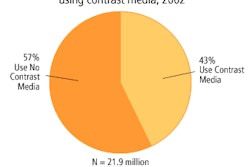SAN ANTONIO - Because radiology is technology-dependent, an entire practice is affected when a modality is out of service. Exams may need to be rescheduled or redirected to other facilities, technologists may be idled, referring physicians have to wait longer than expected for reports, and patient care can be compromised. Meanwhile, the vendor expects the ongoing tab for the acquisition of the broken equipment to be paid in a timely fashion.
A well-negotiated service contract can ensure that a modality is up and running in a timely and cost-efficient manner; a poorly bargained service contract can impact a practice's referrals and carve large bites out of its bottom line, according to Georgann Bruski, a radiologic technologist and manager of invasive cardiology at Beth Israel Deaconess Medical Center in Boston.
"The longer you're down, the more money you're losing and the less you can pay the equipment vendor," she said.
Bruski and Sara Cutler, president of Advance Healthcare Consulting in Schenectady, NY, shared their service-contract negotiation strategies this week at the American Healthcare Radiology Administrators (AHRA) annual meeting. The best advice they offered to attendees was to never sign a preprinted, standard service contract.
"Boiler plate on the back of contracts has all kinds of exceptions and conditions," Cutler said.
The place to begin negotiating a service contract is at the start of an equipment sale, Bruski said.
"It's always better to deal from a position of strength," Cutler explained. "That's why I advise negotiating service contracts when a sale is taking place."
A facility should always request a five-year agreement up front, with the service contract including all software upgrades for that time period. A caveat that Bruski has been successful adding to her contracts is an obsolescence clause.
For example, if a modality's system software is retired in favor of a new application, that new software is provided and installed free of charge. In addition, if the software upgrade requires a hardware upgrade to function correctly, the vendor provides the hardware at no cost.
The standard one-year warranty on parts and service can also be upgraded at the time of the initial sale, generally by six months, Bruski noted.
"You can usually get 18 months on the warranty," she said.
Another service-contract element that Bruski negotiates is the hours of service. It may seem obvious to administrators that their departments or imaging centers are open and running longer than a typical eight-hour workday. However, standard service contracts set service hours between 9 a.m. to 5 p.m., with increased charges for work performed outside those hours.
Bruski advocates defining a standard service workday in the contract as 6:30 a.m. to 7 p.m., which more accurately reflects the workload in her department. In addition, she includes a codicil in her service contracts that required upgrades are to be performed on evenings or weekends, without an extra charge for work performed outside business hours.
As for costs themselves, Bruski insists that they be spelled out in contracts.
"You want to clarify costs on an hourly, daily, and annual basis, as well as over a three-year and five-year period," she said. "This should also include travel and lodging expenses."
She also contractually establishes costs for replacement parts, shipping, and rigging of the equipment, and places remedies in the contract for defaults. These are generally nonperformance penalties that result in service price discounts for the facility.
Bruski sets a time limit for every equipment incident in her contracts. If a problem cannot be solved by local service personnel within a four-hour period, outside assistance must be provided. She also sets a maximum time for delivery of parts in her contract, generally 24 hours.
Personnel training on new systems and equipment is something that Bruski negotiates as part of a sale as well. She always extends the training period to 10 days and specifies the hours of training in her contracts.
In addition, she includes a right-of-refusal clause stipulating that she must meet the support manager and approve of any service personnel that will be performing work in her department. This gives her a chance to evaluate the professionalism of the vendor's support infrastructure and also determine the sense of commitment on the part of the service engineer.
"I have told service engineers that they cannot work in my department," she said.
A strategy that Bruski has found successful is to time sales and service-contract negotiations for a particular time of year, depending on the equipment in question.
"Find out when the company has its fiscal year end, and time your deal for that time," she said.
Often vendors are seeking to boost sales for both the fourth quarter and year end, and are more open to creative negotiation at those times, Bruski said. These negotiations must always be well-documented, as details, especially with service contracts, are particularly important.
"If it's not written, it's not real," she said.
By Jonathan S. Batchelor
AuntMinnie.com staff writer
August 10, 2005
Related Reading
MRI coil failures: Decreasing occurrence and cost, April 20, 2005
Fighting fear, uncertainty, and doubt in asset management, August 9, 2004
Repair charges in five modalities show stability over three-year span, March 29, 2004
MRI/CT maintenance labor rates show biggest increase, August 11, 2003
Spelling out the terms of large equipment purchases, September 20, 2002
Copyright © 2005 AuntMinnie.com



















